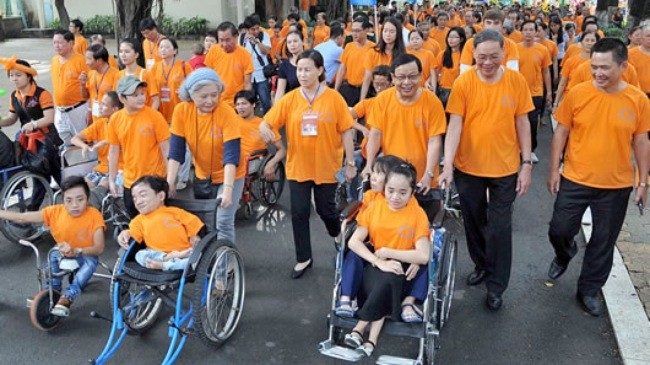(VOVworld) – August 10 is observed as a Day for Vietnamese victims of Agent Orange/ Dioxin. Although the war ended long ago, the Agent Orange/ Dioxin sprayed by the American army is having lingering consequences for millions of Vietnamese. The Vietnamese Party and State have adopted policies and implemented programs to help AO victims.

Walking for victims of Agent Orange/ Dioxin
|
On August 10, 1961, the 1st flight sprayed the defoliant on the town of Kon Tum, beginning the US chemical warfare in southern Vietnam. During the next 10 years, 80 million liters of 20 kinds of toxic chemicals, principally the substance known as Agent Orange/ Dioxin, were sprayed on one-fourth of the area of southern Vietnam. About 4.8 million people were exposed to dioxin and 3 million are still suffering from health problems today.
The community work together
To mark the Day for Vietnamese AO victims, the Vietnam Association of Victims of Agent Orange/ Dioxin (VAVA) launched a nationwide campaign to raise 100,000 USD to buy gifts and provide production loans for the families of 100 AO victims.
Over the past decade, VAVA raised over 46 million USD to build or upgrade 1,000 houses, help thousands of AO victims increase their production, and provided 1,000 scholarships to their children. 30 centers for AO victims were built nationwide. The government has helped VAVA build 3 rehabilitation centers for AO victims in Hanoi, Danang, and Ho Chi Minh city. Nguyen Thi Hien, Chairwoman of the Da Nang Association for AO victims, says: “The life of AO victims has been improved. Our biggest concern now is that there are families with 3 or 4 AO-affected children. Who will take care of them when their parents die? We hope to create stable financing to take care of the AO victims.”
Provinces and organizations have directly donated gifts to local AO victims. Thua Thien-Hue’s Association of AO victims donated 400 gifts, each worth 15 to 50 USD, to AO victims. The Association has collected 150,000 USD to build houses, provide vocational training courses and free medical check-ups, and provide no interest loans to the families of AO victims
Lang Son’s Association of AO victims raised 100,000 USD to build 11 new houses, repair 8 houses, and pay for the treatment of 43 patients.
Le Van Dang, Chairman of Quang Tri’s Association of AO victims, says: “We have used nearly 1 million USD in donations to deliver 22,000 gifts, and build a rehabilitation and vocational training center for AO victims. We’ll ensure good treatment for the patients here.”
More incentives for AO victims
Since 2000 Vietnam has provided incentives for revolutionaries affected with dioxin. VAVA’s Chairman, Senior Lieutenant general Nguyen Van Rinh, said Vietnam has about 300,000 people who were directly involved in the revolution and their children have a monthly allowance ranging from 40 to 100 USD. For 2nd and 3rd generation victims of AO/dioxin, the government pays part of their medical insurance and gives them free schooling.
About one third of the AO victims now have medical insurance. 25% of AO children have access to rehabilitation services. Since 2000 the government has implemented policies on vocational training, employment, loans for production, and medical treatment.
In addition to incentive policies and support for AO victims, VAVA will continue to pursue their lawsuit against the American companies that produced and supplied the toxic chemicals to the US army. Mr. Rinh said: “We have increased communications to make Vietnamese and people worldwide understand the destructive consequences of chemical warfare. We will press our claims for justice for Vietnamese AO victims in the courts and outside the courts. We’ll persuade the US government to provide humanitarian aid to AO victims and American chemical companies to compensate the victims, help disinfect the environment, and build healthcare facilities for AO victims.”
Party and State policies and the community’s support will help ease the physical and emotional pain of AO victims.